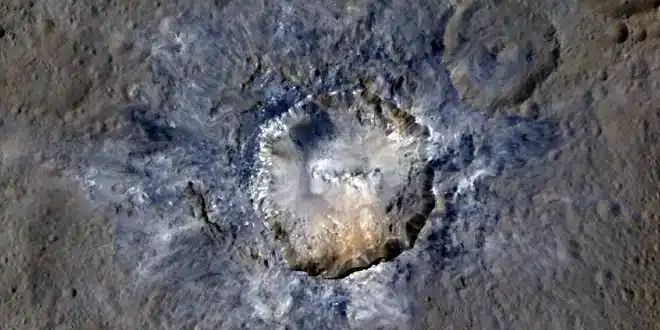A recent study published in the journal Science Advances suggests that the asteroid belt between Mars and Jupiter, particularly focusing on the dwarf planet Ceres, might contain the essential building blocks of life. Ceres, the largest object in the asteroid belt, has an icy exterior beneath which lie several small subterranean bodies of saltwater.
One of Ceres’s largest craters, known as the Ertunet Crater, is a site of significant interest. Maria Cristina De Sanctis, a planetary scientist at Italy’s National Institute for Astrophysics, along with her team, discovered organic chemicals known as aliphatics in the area surrounding this crater. These chemicals cover hundreds of square miles and are believed to have formed relatively recently, within the last few million years. This timeframe is proposed because aliphatic compounds are not stable under the continuous exposure to space radiation for extended periods.
The researchers used data from NASA’s Dawn mission, which passed by the dwarf planet in 2012, to recreate Ceres sediment in their laboratory. They included aliphatic organics in their experiment, which were identified near the Ertunet Crater, to determine their age. By subjecting the mixture to intense ultraviolet radiation and fast-moving ions—a process mimicking space weathering—they concluded that these organic molecules degrade quickly, indicating they have not been on Ceres for very long.
Their presence in abundance on the surface suggests that these hydrocarbons have surfaced within the last 10 million years. The study further notes that these organic compounds likely evolved over the lifespan of Ceres’s ancient ocean, which may have persisted for at least a few hundred million years. The researchers also determined through simulations that these molecules were not brought to Ceres by any external bodies like asteroids or comets but instead formed internally.
Originally, Ceres was covered by a vast ocean beneath its crust, though now only remnants of this ocean exist. Prior research suggests that interactions between rock and saltwater beneath Ceres’s surface might have created conditions suitable for life by releasing energy.
Given these findings, the study’s authors advocate for Ceres as a prime candidate for future missions, whether to conduct on-site analysis or to return samples to Earth, due to its potential to teach us more about the origins of life in our solar system.


